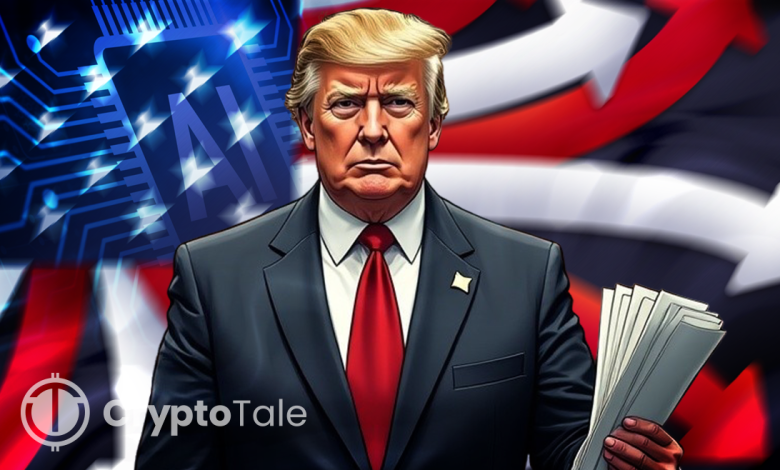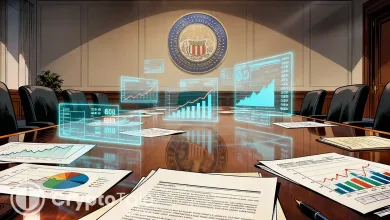Trump’s AI Orders Target ‘Woke’ Models and Global Tech Rise

- Trump’s AI orders cut delays and open funding for faster data center projects nationwide.
- The policy blocks biased AI systems from getting federal contracts or support.
- Crypto tools utilizing AI may soon be subject to the same government standards and vetting rules.
President Trump signed three executive orders on July 23, 2025, aiming to expand U.S. AI infrastructure, boost AI model exports, and eliminate federal support for ideologically biased AI systems. The orders were signed during a live broadcast from Washington’s Mellon Auditorium and drew direct applause from industry leaders as Trump pledged to remove barriers slowing AI development and protect the nation’s technology pipeline from “radical ideological” interference.
These sweeping measures, as reported by The Financial Times, form the foundation of a broader federal strategy that could influence the future of blockchain regulation and digital finance as well.
Data Center Acceleration and Infrastructure Deregulation
The first executive order fast-tracks federal permitting for large-scale data centers by removing Biden-era environmental and DEI compliance policies. The order also authorizes the use of federal lands and introduces grants, tax incentives, and guaranteed loans to attract infrastructure investment. Tech giants including Nvidia, AMD, and Meta have welcomed the move, citing its potential to dramatically scale AI computing capacity across the United States.
The initiative is consistent with industry requests, such as the one voiced by Compute Exchange, whose co-founder Simeon Bochev called for less permitting delays and state-to-state inconsistency. The order elicits concerns that it would weaken environmental regulations and delegitimize states’ regulatory abilities, but proponents of the order believe that the American AI industry requires approvals to stay competitive in the world market.
Trump told the audience, “We are getting rid of woke. Is that OK?” drawing strong applause before signing the orders on stage. He also accused Joe Biden’s AI policies of embedding “toxic diversity, equity, and inclusion ideology” into federal tech standards. “So you immediately knew that was the end of your development,” Trump said, prompting laughter from the attending business executives.
Export Powerhouse Vision and Anti-Bias Procurement Reform
The second order instructs the Commerce Department, Treasury, and Ex-Im Bank to expand U.S. AI exports and position the country as a global AI supplier. The initiative focuses on chipsets, software platforms, and hosted model services, tapping federal diplomacy to compete with China and allied states. Trump declared this export-first model as central to making the United States “an AI export powerhouse.”
Meanwhile, the third order bars federal contracts from funding AI systems that promote DEI content or similar ideological frameworks. Under the “Unbiased AI Principles,” models must demonstrate political neutrality and factual outputs to qualify for government use. The General Services Administration and other agencies will enforce a review framework to identify systems exhibiting ideological slant.
As explained by the White House press team, the rules apply to any company receiving federal AI funding and are part of a wider clampdown on diversity-themed policies within government operations, including education and defense. Trump’s stated goal is to restore public trust in federally backed algorithms by eliminating “woke Marxist lunacy” from the software design process.
Related: TRUMP Token Boosts Reach with its Move to TRON via LayerZero
Policy Framework for Blockchain and Crypto Regulation
These AI reforms show digital policy harmony, which may have an impact on crypto and Web3 systems. Developers of blockchain who use AI-based auditing, automated compliance, and validation of smart contracts can be examined in the light of these principles.
As national AI oversight intensifies, crypto may find itself bound to similar frameworks involving neutrality, transparency, and public-interest compliance. The effect could be a dual-track U.S. policy standardizing both AI and blockchain systems under trusted design. With Trump repealing Biden’s Executive Order 14110 and strengthening guidance through E.O. 14179 earlier this year, these July orders build momentum toward a digital infrastructure blueprint. Entrepreneurs operating at the edge of AI and blockchain convergence now face a signal: neutrality, performance, and security will govern the future for federal partnerships and public deployment.




